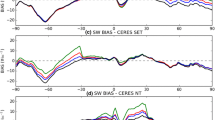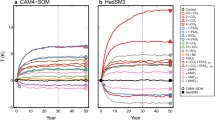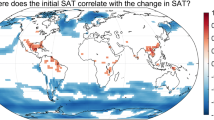Abstract.
The effect of employing flux adjustments on the climatic response of an idealized coupled model to an imposed radiative forcing is investigated with two coupled models, one of which employs flux adjustments. A linear reduction (to the planetary longwave flux) of 4 W/m2 is applied over a 70 y period and held constant thereafter. Similar model responses are found (during the initial 70 y period) for global-scale diagnostics of hemispheric air temperature due to the nearly linear surface-air temperature response to the radiative forcing. Significant regional scale differences do exist, however. As the perturbation away from the present climate grows, basin-scale diagnostics (such as meridional overturning rates) begin to diverge between flux adjusted and non-flux adjusted models. Once the imposed radiative forcing is held constant, differences in global mean air temperature of up to 0.5 °C are found, with large regional-scale differences in air temperature and overturning rates within the North Atlantic and Southern Ocean. Two additional experiments with the flux adjusted model (beginning from points further along the control integration) suggest that the elimination of much of the coupling shock before the radiative forcing is applied leads to results slightly closer to the non-flux adjusted case, although large differences still persist. In particular a dipole structure indicating an enhanced warming within the Pacific sector of the Southern Ocean, and cooling within the Atlantic sector is not reproduced by the flux adjusted models. This disparity is intimately linked to the Southern Ocean overturning cell along with the flux adjustments employed as well as the drift arising from coupling shock. If a similar form of sensitivity exists in more realistic coupled models, our results suggest: (1) perturbation experiments should not be undertaken until after the coupled model control experiment is carried out for several hundred years (thereby minimizing the coupling shock); (2) care should be exercised in the interpretation of regional-scale results (over the ocean) in coupled models which employ flux adjustments; (3) care should also be taken in interpreting even global-scale diagnostics in flux adjusted models for large perturbations about the present climate.
Similar content being viewed by others
Author information
Authors and Affiliations
Additional information
Received: 15 November 1996 / Accepted: 4 June 1997
Rights and permissions
About this article
Cite this article
Fanning, A., Weaver, A. On the role of flux adjustments in an idealized coupled climate model. Climate Dynamics 13, 691–701 (1997). https://doi.org/10.1007/s003820050191
Issue Date:
DOI: https://doi.org/10.1007/s003820050191




